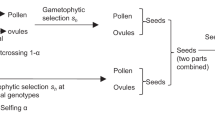Summary
Migrants between plant populations may represent a random sample of the donor population or may be related, being identical in the extreme. There is considerable potential for kin-structured migration in many plant species through the co-dispersal of seeds from single individuals. Through simulation experiments we have shown that the greater the level of relatedness of migrants, the less a given level of migration counterbalances the effect of genetic drift among populations.
Similar content being viewed by others
References
Bygott GD, Bertram BCR, Hanby JP (1979) Male lions in large coalitions gain reproductive advantages. Nature 282:839–841
Cheney DL (1983) Proximate and ultimate factors related to the distribution of male migration. In: Hinde RA (ed) Primate social relationships: an integrated approach. Sinauer, Sunderland/MA, pp 241–249
Chepko-Sade D, Sade DS (1979) Patterns of group splitting within matrilineal kinship groups: A study of social group structure in Macaca mulatta (Cercopithidae, Primates). Behav Ecol Sociobiol 5:67–86
Cheverud JM, Dow MM (1985) An autocorrelation analysis of genetic variation due to lineal fission in social groups of Rhesus macaques. Am J Phys Anthropol 67:113–122
Cheverud JM, Buettner-Janusch J, Sade D (1978) Social group fission and the origin of intergroup genetic differentiation among the rhesus monkeys of Cayo Santiago. Am J Phys Anthropol 49:449–456
Coles JF, Fowler DP (1976) Inbreeding in neighboring trees in two white spruce populations. Silvae Genet 25:29–34
Colvin J (1983) Influences of the social situation on male emigration. In: Hinde RA (ed) Primate social relationships: an integrated approach. Sinauer, Sunderland/MA, pp 160–171
Duggleby C (1977) Blood group antigens and the population genetics of Macaco mulatta adults on Cayo Santiago. II. Effects of social group division. Year Phys Anthropol 20:263–271
Faegri K, van der Pijl L (1979) The principles of pollination ecology, 3rd edn. Pergamon, Oxford
Fix AG (1975) Fission-fusion and lineal effect: aspects of the population structure of the Semai Senoi of Malaysia. Am J Phys Anthropol 43:295–302
Fix AG (1978) The role of kin-structured migration in genetic microdifferentiation. Ann Hum Genet 41:329–339
Fix AG (1981) Kin-structured migration and the rate of advance of an advantageous gene. Am J Phys Anthropol 55:433–442
Fix AG (1985) Evolution of altruism in kin-structured and random subdivided populations. Evolution 39:928–929
Furuya Y (1968) On the fission of troops of Japanese monkeys. Primates 9:323–349
Hamrick JL (1987) Gene flow and the distribution of genetic variation in plant populations. In: Urbanska KM (ed) Differentiation patterns in higher plants. Academic Press, New York, pp 53–67
Lee PC (1983) Home range territory and intergroup encounters. In: Hinde RA (ed) Primate social relationships: an integrated approach. Sinauer, Sunderland/MA, pp 231–253
Levin DA (1984) Proximity-dependent crossing success in Phlox drummondii. Evolution 38:116–127
Nash LT (1976) Troop fission in free-ranging baboons in the Gombe Stream National Park, Tanzania. Am J Phys Anthropol 48:63–77
Neel JV, Salzano F (1976) Further studies on the Xavante Indians. X. Some hypotheses-generalizations resulting from these studies. Am J Hum Genet 19:554–574
O'Rourke D, Bach Enciso V (1982) Primate social organization, ecology and genetic variation. In: Crawford M, Mielke J (eds) Current developments in anthropological genetics. Ecology and Population Structure. Plenum Press, New York, vol. 2, pp 1–28
Park YS, Fowler DP (1982) Effects of inbreeding and genetic variances in a natural population of tamarck (Larix laricina (Du Roi) K. Koch) in eastern Canada. Silvae Genet 31:21–26
Pijl L van der (1972) Principles of dispersal in higher plants. 2nd edn. Springer, Berlin Heidelberg New York
Richards AJ (1986) Plant breeding systems. Allen and Unwin, London
Rogers AR (1987) A model of kin-structured migration. Evolution 41:417–426
Rogers AR, Jorde LB (1987) The effect of non-random migration on genetic differences between populations. Ann Hum Genet 51:169–176
Slatkin M (1976) The rate of spread of an advantageous allele in a subdivided population. In: Karlin S, Nevo E (eds) Population genetics and ecology. Academic Press, New York, pp 767–779
Smouse PE, Vitzthum VJ, Neel JV (1981) The impact of random and lineal fission on the genetic divergence of small human groups: A case study among the Yanomama. Genetics 98:179–197
Squillace AE (1974) Average genetic correlations among offspring from open-pollinated forest trees. Silvae Genet 23:149–156
Waser NM, Price MV (1983) Optimal and actual outcrossing in plants, and the nature of plant-pollinator interaction. In: Jones CE, Little RJ (eds) Handbook of experimental pollination ecology. Van Nostrand Reinhold, New York, pp 341–359
Wright S (1922) Coefficients of inbreeding and relationship. Am Nat 56:330–338
Author information
Authors and Affiliations
Additional information
Communicated by P. M. A. Tigerstedt
Rights and permissions
About this article
Cite this article
Levin, D.A., Fix, A.G. A model of kin-migration in plants. Theoret. Appl. Genetics 77, 332–336 (1989). https://doi.org/10.1007/BF00305824
Received:
Accepted:
Issue Date:
DOI: https://doi.org/10.1007/BF00305824




